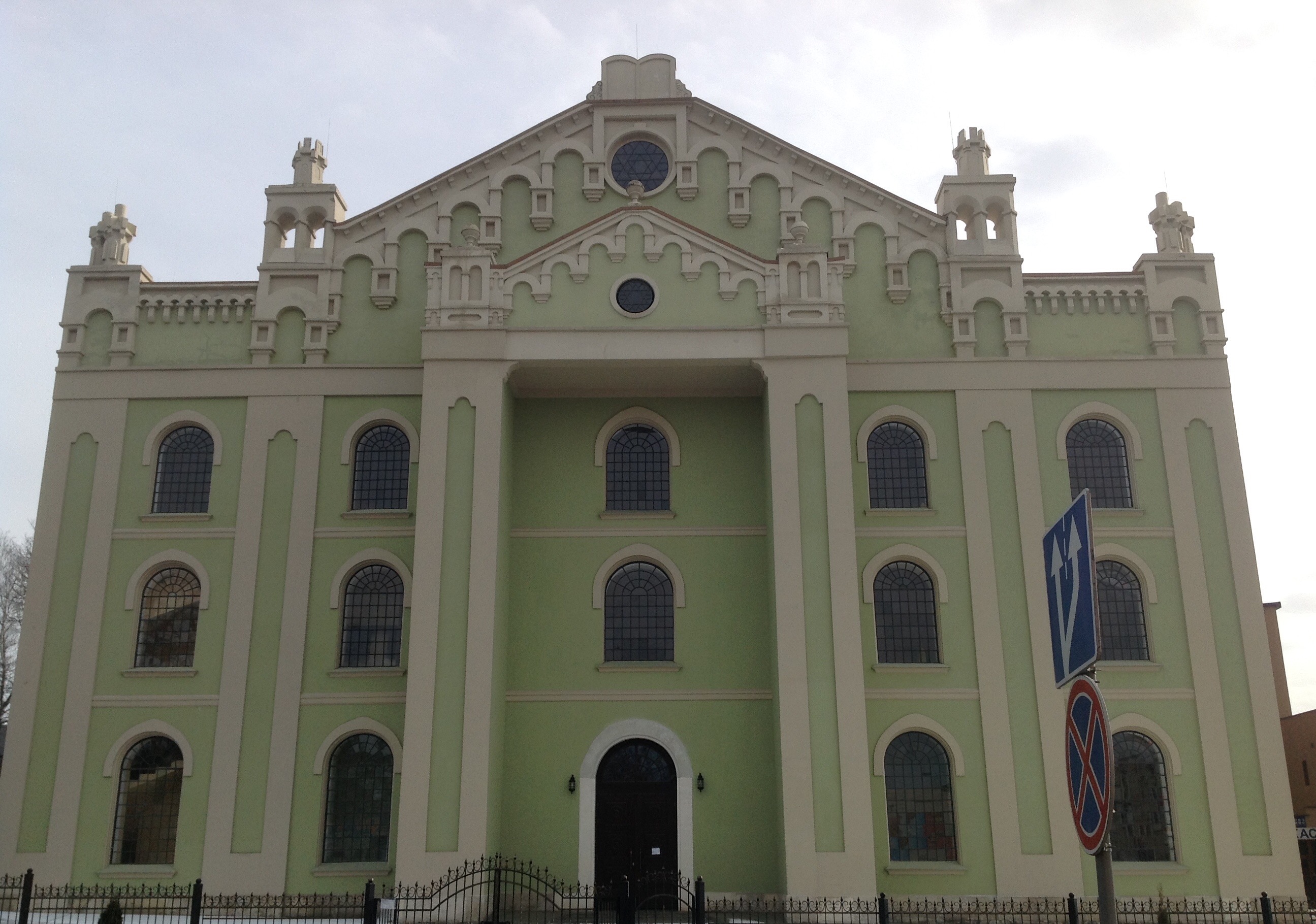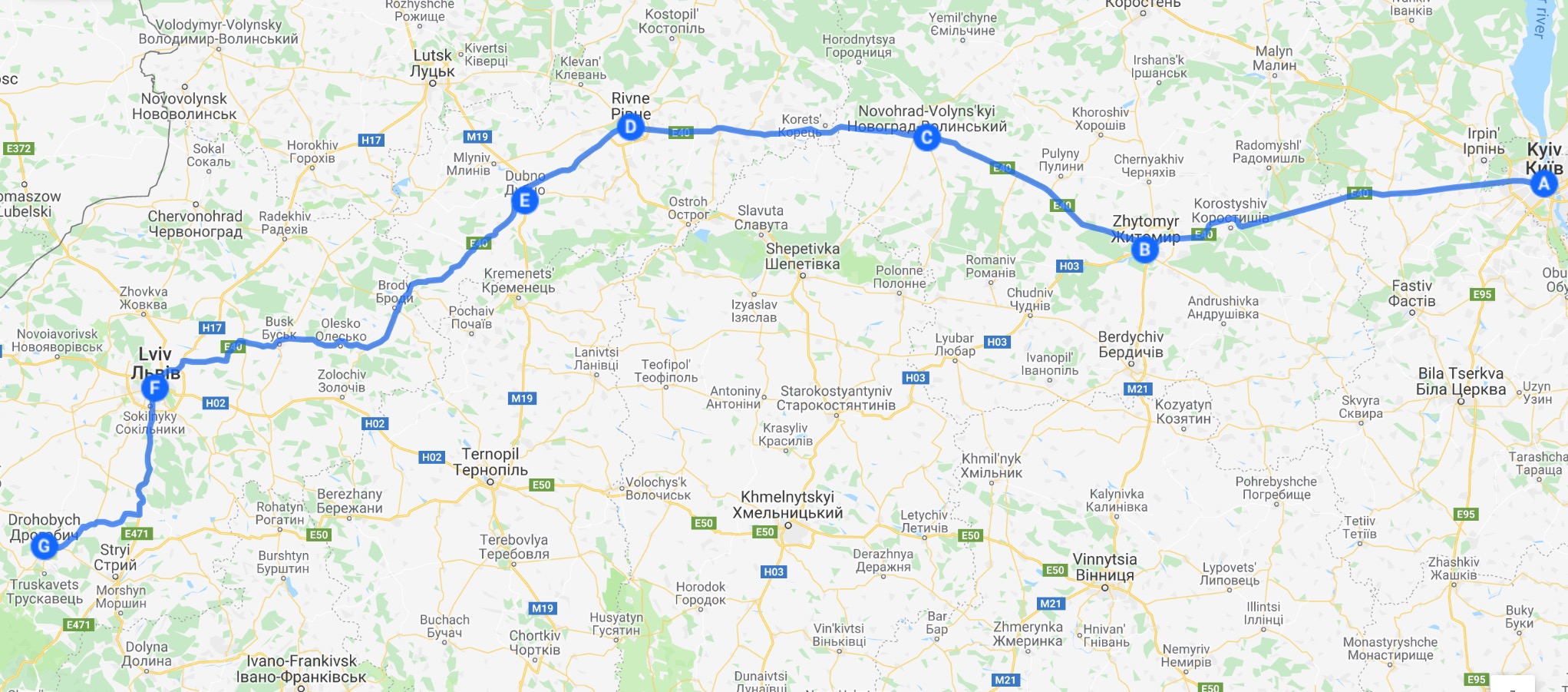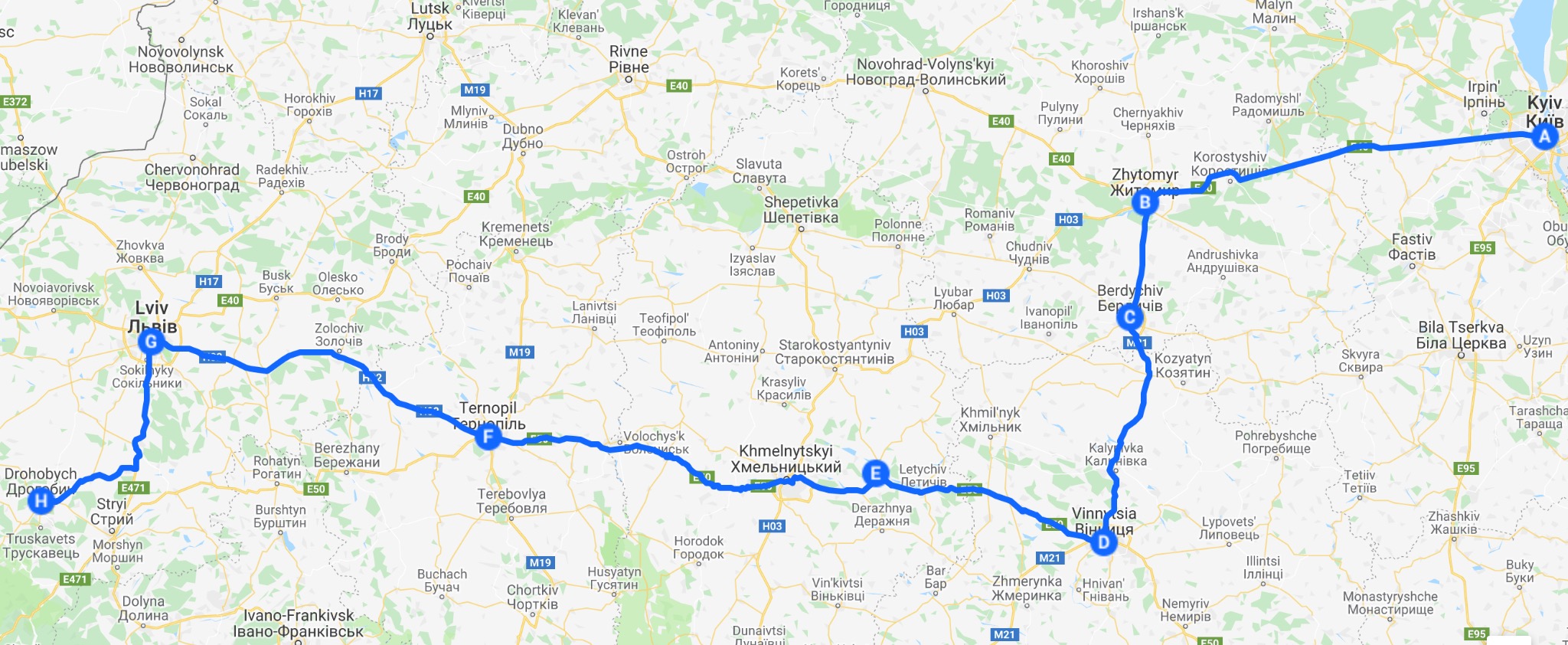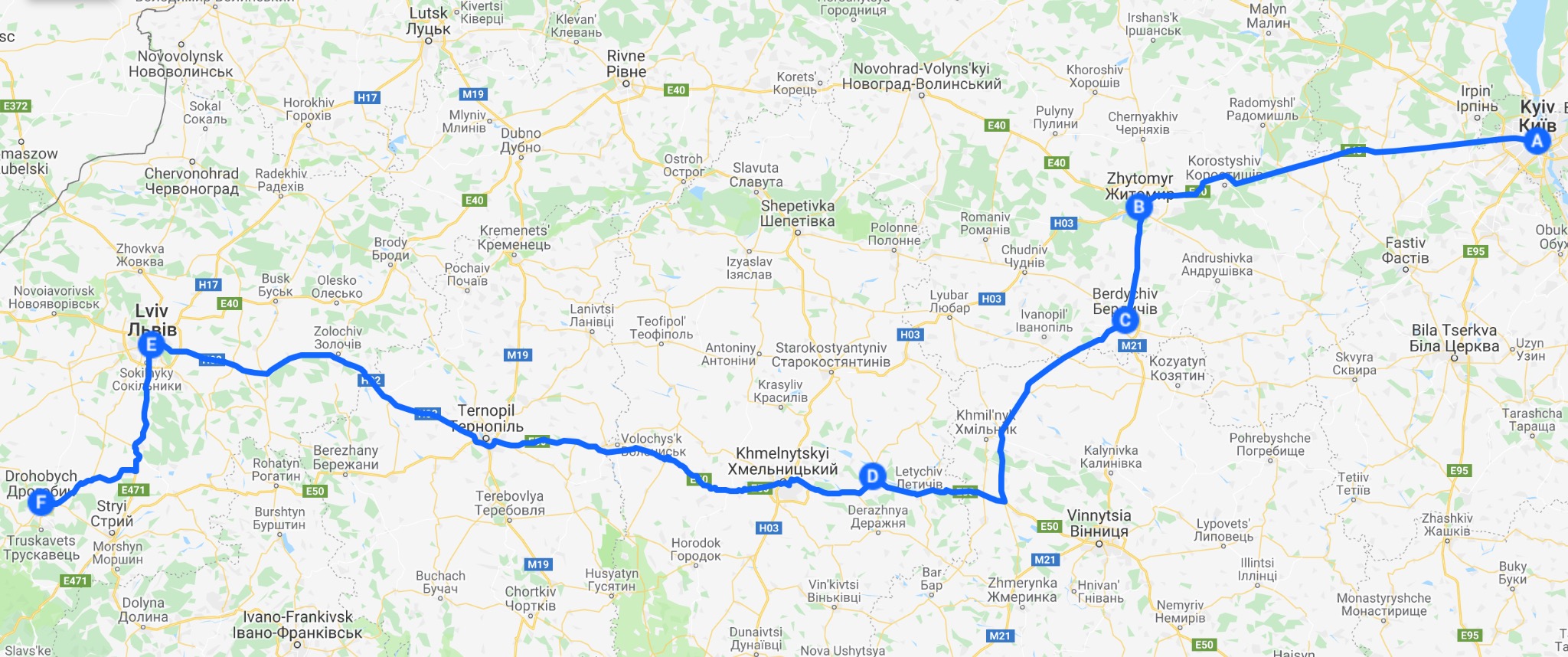Variants of routes from Kyiv to Drohobych by car:
1) 630 km
Kyiv - Zhytomyr - Novohrad-Volynskyi - Rivne - Dubno - Lviv - Drohobych
2) 710 km
Kyiv - Zhytomyr - Berdychiv - Vinnytsia - Letychiv - Medzhybizh - Ternopil - Lviv - Drohobych
3) 670 km
Kyiv - Zhytomyr - Berdychiv - Khmilnyk - Letychiv - Medzhybizh - Ternopil - Lviv - Drohobych
(Yiddish: דראָהאָביטש, also known as Drogobych, Drohobycz, Drohobitch, Drohobytsch, Drohobics, Drogobycz, Drogobich, Drohobich, Drohobyc, Drobich, Dobrovlyany, Dobrowlany)
The history of the Jewish people in Drohobycz and Boryslaw is centuries' old. The discovery of oil in the mid-19th Century, however, changed the course of the two towns' history and the development of their Jewish communities. Neither Drohobycz nor Boryslaw could be described as typical Galician "shtetls". The unprecedented wealth generated from the oil industry drew people and foreign companies to the region. Boryslaw, the production center for crude oil and natural wax, developed into a sprawling boom town, while Drohobycz became the urban hub of the Galician oil belt. By the 1870s Drohobycz was considered the third wealthiest city in Galicia.
Estimated at 11,500 in 1870, Jews comprised more than half of the combined total population of both cities. At that time, Jews were granted full civil equality under Emperor Franz Josef and restrictions previously placed on religious community organization were lifted. These reforms enabled greater Jewish economic and social integration on the one hand and greater community expression and organization on the other. The Great Synagogue was built in Drohobycz and modern Jewish schools, a hospital and other community services were established in both towns.
The Jewish communities of Boryslaw and Drohobycz, two neighboring towns in east Galicia, shared a history and legacy, which is at the same time both typical of Polish Jewish communities and unique. The two towns comprised the epicenter of Galicia's oil belt, a fact which not only shaped their socio-economic and cultural development prior to World War II but defined their role, as a temporary "last refuge" for Jews in the entire region during the war.
The exhibition of Drohobych Sinagogue tells the tale of Drohobycz's and Boryslaw's vibrant Jewish communities and documents their brutal demise during the Holocaust. It highlights the story of Bruno Schulz, whose murder serves today as a metaphor for the annihilation of an entire community in its prime. It also pays tribute to the Righteous Among Nations from the two towns, non-Jews who risked their and their families' lives to aid Jews. Four of these, Ebenhard & Donata Helmrich and Berthold & Else Beitz, were Germans, who used their respective positions to save Jewish lives.
 In the mid-19th Century, oil was discovered in Boryslaw and its environs. A "black gold" rush ensued, as thousands poured into the "Galicia's California" to seek their fortune. By the end of the century, Boryslaw became one of the largest oil towns in the world. Drohobycz served as the region's refining and financial centre. At its peak in 1909, Boryslaw produced 1.9 million tons of crude oil and was considered the third largest oil producer in the world. On the eve of WWII, production levels were less than one fifth of peak levels. Still the oil fields attracted the interest of both the Soviets and the Third Reich.
In the mid-19th Century, oil was discovered in Boryslaw and its environs. A "black gold" rush ensued, as thousands poured into the "Galicia's California" to seek their fortune. By the end of the century, Boryslaw became one of the largest oil towns in the world. Drohobycz served as the region's refining and financial centre. At its peak in 1909, Boryslaw produced 1.9 million tons of crude oil and was considered the third largest oil producer in the world. On the eve of WWII, production levels were less than one fifth of peak levels. Still the oil fields attracted the interest of both the Soviets and the Third Reich.
Jews played a pioneering and often pivotal role in the development of the Galician oil industry. They were among the first to extract and distil Galician crude. In the early days, the majority of owners of the many small-scale oil firms were Jewish. Throughout the industry's history, many of the managers and scientific and technical professionals in both large and small enterprises were Jews, who were also prominent in developing industry-related enterprises and technology.
The economic, demographic and social developments of the late 19th and early 20th centuries provided fertile ground for the cultivation of a rich and diverse cultural life in Drohobycz and Boryslaw. Their dynamic, multicultural environment sparked outstanding creativety. A relatively large number of, highly talented people, including artists, writers, painters, intellectuals and activists emerged from the ranks of the Jewish community.
On the eve of the German invasion of Poland in September 1939, Hitler and Stalin signed the Ribbentrop-Molotov non-aggression pact, under which Drohobycz and Boryslaw became part of the Soviet Ukraine. Life changed radically for everyone in the two towns. Prominent local leaders, intellectuals, and social elites Jews, Poles and Ukrainians alike were arrested and many deported. The oil industry was nationalised and consolidated. Businesses and propertywereconfiscatedandmanyoftheproprietors exiled.
"... This unforgettable Friday, September 1, 1939, I went into town. It was a sunny day. Suddenly "big black birds" appeared in the blue sky - German bombers.... Together from the balcony, we watched Polmin, the government refinery, go up in flames" (Bella Brawer-Tepper, Drohoybcz survivor, Partial Autobiography)
Two and a half weeks after the outbreak of the war, the Soviet Union took control over Galicia and the oil industry was immediately nationalized. While many "capitalists" from Drohobycz and Boryslaw were exiled to Siberia, skilled oil professionals were allowed to retain their positions.
"Immediately after Russian soldiers marched into Drohobycz, they came to our house and announced that we could not live alone in such a big house.... My father's business was taken away from him and he had no income.... He was given a special passport by the Russians which had a paragraph in it describing him as "undesirable element",,, (Polo Arbiser, Give Me the Children)
Soviet rule affected the lives of the Jewish population significantly - albeit differentially. Zionist activists were arrested and deported, as were many wealthy Jews and refugees from western Poland. The Jewish Kehilla was disbanded and religious schools closed. In contrast, the nationalisation of secondary and university education brought new opportunities to less wealthy Jews. On the eve of the German invasion of Russia on June 22, many men were conscripted to the Red Army and some families left
with the retreating Soviet troops. Most, unfortunately, opted to stay.
" First they took away pianos, then people. Trotskyists, Zionists, Bundists, Petlurites, Pilsudski Legionnaires, National Democrats ... Our cousin, Lipe Erdman, was deported for selling a kilo of sugar on the sly. Doctor Adlersberg, Doctor Nacht, and Doctor Pachtman were taken for no reason. (Henryk Grynberg, Drohobycz).
The Germans entered Boryslaw and Drohobycz on June 30, 1941. A day later pogroms were instigated by certain factions of the local Ukrainian population in 31 towns, as the Germans stood by and looked on. When the Ukrainians dragged us to the courthouse, they took us to see twelve or so dead bodies of Ukrainian prisoners. They had been ' illed by the Russian secret police before they. (Bernard Meyer, Drohobycz survivor).
"In June 1941 the Germans occupied our town instead of the Russians. At first we were happy with the change. Father knew Germany, having traveled there often on business. He considered the Germans cultured and civilized, unlike the barbaric Russians. Our perception changed quickly, however, with the first pogrom." (Irene Fnsch, Drohobycz survivor, And Life Is Changed Forever).
The pogroms in Boryslaw and Drohobycz were triggered by the discovery of dead bodies at the Soviet Secret Service (NKVD) headquarters. The rumour that 'Jewish Bolshevism' was responsible for the massacre quickly spread. Jews were taken from their homes and forced to wash and remove the corpses. Peasants from surrounding areas armed with axes, clubs, and pitch forks looted Jewish homes and shops, beating hundreds of Jews. The German Wehrmacht eventually put an end to the murder and plunder, which left hundreds of Jews dead.
It was later discovered that on June 29, 1941, prior to the outbreak of violence, Reinhard Heydrich, head of the Third Reich's security service, telexed orders to either incite or intensify such pogroms without leaving evidence of German complicity.
A few days after the Nazi invasion in 1941, a series of orders and restrictions were imposed on the Jewish population, culminating in the suspension of all legal rights. All Jews were forced to wear a white armband with a Star of David at all times. They could not use any means of public or private transportation, nor could they leave the city or be on the streets after sunset. Entrance to all public buildings, theaters, parks and libraries was denied. Arms, phones, radios, bicycles, livestock, pets, furs, furniture and jewels had to be surrendered to the German authorities. Trade with the Aryan population was illegal. Violation of the new laws was punishable by death.
" The decrees and declarations fell upon the Jewis population one after the other and struck with a force like thunder after lightning, with a growing frequency as Nazi rule became established in the city... The armband was in fact a notification that the wearer is devoid of any human rights." (Notebooks of Amolia Buchmonn, Drohobycz survivor)
Forced labour was imposed on all Jewish men and women, who were assigned the most exacting physical jobs. They were often grabbed off the streets for this. In July 1941, 20 Jewish workers were shot in Drohobycz as collective punishment for the failure of 17 others to report to work.
The occupation government implemented a strict, racially differentiated system of food rationing. In the district of Drohobycz, annual rations of flour were three times higher for Germans than for Jews, who were entirely denied meat, fat, eggs and other staples. food outlets remained stocked. In the words of c survivor: "We had ration coupons, but no ration,. Starvation and disease, induced by the abject poverty under which Jews were forced to live, became acute as the winter of 1941-1942 set in. Hundreds died on the streets.
The Wehrmacht's failure to conquer the oil fields near Baku rendered the Galician oil fields more crucial for the production and supply of fuel. The oil industry was now considered essential for the German war effort and Jews working in it were temporarily spared arrest and murder. In November 1942, the Mraznica labour camp was established in Boryslaw and "R" (essential defence industry) tags were distributed to 1,670 oil industry workers. In Drohobycz, ten labour camps, including an oil refinery, a roof tile factory, light industry workshops and even a produce farm, operated in and around town. As the German forces continued to liquidate the ghettos throughout the region, the labour camps, particularly Mraznica, became temporary safe-havens, housing both legal ("R"-tag) and so- called "illegal" inhabitants.
The Akcionen continued until the final days of German occupation. After the closure of Betzec in December, 1942, the German forces reverted to conducting mass executions locally. In Boryslaw, the municipal slaughterhouse became the primary venue for execution and outside of Drohobycz, thousands of Jews were shot in the Bronica Forest.
The Aktionen claimed tens of thousands of victims and left survivors in a constant state of terror. In August-November, 1942 alone, the number of Jews rounded up and murdered in Belzec exceeded one half of Drohobycz-Boryslav/s pre-war Jewish population. The Aktionen conducted in November 1942 lasted an entire month.
"...They drove them out to the slaughterhouse and lined them up next to ditches, shooting them from behind, so that they fell into the ditch. They told the last group to cover the ditch with dirt and afterwards the Ukrainian militia and the Germans shot them as well...The next day, workers on their way to work...said that they saw that here and there, the earth, soaked in blood, was still moving." (Beno Ringler, Boryslaw survivor).
Ghettoization was an integral part of the Nazi policy, which facilitated the extermination of entire Jewish communities. The ghetto in Boryslaw, and initially in Drohobycz, was an "open" ghetto! guarded but not fenced in. The wretched living conditions in the ghettos fueled epidemics and many died of typhus. After consecutive Aktionen reduced the Jewish population in both towns, the ghettos were made even smaller and more crowded. In the fall of 1942, the Drohobycz ghetto was fenced in and the Mraznica forced labour camp was established in Boryslaw for Jewish oil workers. In contrast to ghetto dwellers, these workers were provisionally protected from roundup and deportation. Both ghettos were liquidated in the spring of 1943. The Drohobycz ghetto was set on fire in June. With the demise of the ghetto and the liquidation of labour camps, more Jews went into hiding. Some hid with non-Jews, who risked their lives to provide shelter. Others hid in dugouts in the surrounding forests and in "bunkers" built in just about any place imaginable, in and out of town.
One by one, most of the Drohobycz work camps were liquidated throughout the summer of 1943. Mraznica and "Beskidin" the oil refinery camp in Drohobycz continued to operate. By the end of 1943, however, inmates knew that time was running out.
Jewish Population,
June 1941 Boryslaw: 13,000-14,000 | Total: 28,000-31,000 | Drohobycz: 15,000-17,000.
October 1941: Pogroms, executions, random killings and food rationing kill 530-800 Jews in both towns.
November - December 1941: 250-400 Jews from Drohobycz shot in Bronica forest. 1,000-1,500 from Boryslaw shot in Tustanowice forests. Hundreds in both cities die from exposure, starvation and disease.
January 1942 Boryslaw: 10,000-11,000 | Total: 22,800-27,000 | Drohobycz: 12,800-16,000
October 1942 Boryslaw: 4,860 | Total: 10,160-15,760 | Drohobycz: 5,300-10,900.
November 1942: Four-weak Aktion leaves 3,000 from Boryslaw an 1,000-2,000 from Drohobycz dead. Shooting of 150-300 Jews on the streets of Drohobycz.
February 1943:500-600 Jews shot near the Boryslaw slaughterhouse, 500 from Drohobycz shot In Bronlca for Bit.
May 1943: In Boryslaw 500-700 shot at the slaughterhouse, including members of the Judenrat and Jewish police.
June 1943 - ianuary 1944: Liquidation of the ghettos and many work camps leaves 1,270-1,570 Jews shot In Drohobycz and 500-700 in Boryslaw.
April 1944: 1,000 Jews transported from Boryslaw and Drohobycz.
June-July 1944: Mraznica labour camp liquidated. Remaining inmates sent to Plaszow.
"The Nazi vocabulary was one of euphemisms. Liquidation, transport, action, selection, resettlement, relocation, labour camp, deportation - these matter-of-fact words hid the most sinister of intents, the most evil of motives. The purpose of an Aktion was to swoop on communities of Jews and round them up to be murdered or transported to concentration camps." (Sabina Wolanski, Boryslaw survivor)
The systematic mass murder of Jews in Drohobycz and Boryslaw started in November 1941. In Drohobycz, the Judenrat (Jewish Council) was ordered to compile a list of 350-400 unemployed Jews who were summoned to the Employment Office on November 22, 1941. About 250 adults and an unknown number of children appeared. They were driven in trucks to the Bronica Forest and shot by a firing squad. Five days later a similar "Aktion" was carried out in Boryslaw. From this point forward, throughout the entire Nazi occupation, Aktionen were conducted periodically, in the implementation of what came to be called Endlosung (the "Final Solution"), i.e., the total annihilation of European Jewry. An Aktion conducted in March, 1942 culminated in the first deportation of Drohobycz Jews to the Befzec extermination camp.
By the summer of 1944, the German army was in retreat, and the front moved westward. The Aktlonen in Boryslaw and Drohobycz continued and those captured were either killed on the spot or brought to Mrainica. They were later transported to concentration camps. The last transport from Boryslaw pulled into Auschwitz in early August, as the Drohobycz district was being liberated. Drohobycz was liberated on August 6, 1944 and Boryslaw the following day. Survivors gradually emerged from local hideouts and forest bunkers. Elated and dazed, they spent their first days of freedom seeking lodging and searching for loved ones.
For those transported to concentration camps in the months preceding East Galicia's liberation, the summer of 1944 was the beginning of an odyssey through hell. Between July and October, in wake of the liquidation of Plaszow, survivors were sent to oth concentration camps, including Auschwitz, Stutth Flossenburg, Gross-Rosen and Mauthausen. Ma perished in the 9 months between August 7, 1944 and May 7, 1945.
Alfred Schreyer (1922-2015) - Musician and singer (Mine ShtetlBelz and many others), the so-called "Last Jew from Drohobycz", Schreyer grew up in Drohobycz, survived the Holocaust and returned to live there after the war. In his music and stories, Schreyer preserved the history and cultural legacy of Drohobycz's and Galicia's Jewish communities. Alfred Schreyer was a student of Bruno Schulz, a teacher he admired for his creativity, eloquence and extraordinary command of the Polish language. Learning from his former teacher, Schreyer himself became an engaging narrator and storyteller, illuminating Drohobycz's Jewish history and breathing life into its legends. He had been active in the past decades in recovering Schulz's works and promoting his legacy. Schreyer's elegant yet warm demeanor together with his unbridled optimism touched all who came in contact with him. As both an individual and cultural icon, Schreyer was an exceptional person, whose presence and music is sorely missed in Drohobycz.
Drohobych born famous Jews:
Wilhelm Dichter (b. 1935) - Engineer and novelist, a ative son of Boryslaw, who survived the war in hiding, er the war, Dichter immigrated to the United States, turned to writing drawing on his experiences in rfslaw, communist Poland and the U.S. (God's e, The Atheists' School, Learning English).
Shevach Weiss (b. 1935) - Born in Boryslaw, he is a Holocaust survivor who became one of Israel's most prominent figures. He served as Speaker of the Knesset, Chairman of the Yad Vashem Directorate, Israeli Ambassador to Poland, and is a noted writer and lecturer.
Maurycy Gottlieb (1836-1879) - Born in Drohobycz, Gottlieb is considered one of the most prominent late 19th century Polish painters and an innovator in Jewish art (Jews Praying in the Synagogue on Yom Kippur, Shylock and Jessica, Head of a Jewish Bride and others).
Leopold Gottlieb (1879-1934) - A Modernist painter, born in Drohobycz and Maurycy's younger brother (Compassion, Women with a Tulip, White Women and others). He joined the Polish Legions in World War I.
Ephraim Mosef Lilien (1874-1925) - Born in Drohobycz, Liliel was a painter, photographer and illustrator, and fne of the founders of the Bezalel Academy of Art in Jerusalem. Lilien etched and ilustrated in the Art Nouveau style. He is considered one of the greatest Jewish artists, who laid the Inundations of Zionist illustration.
Drohobych - Lviv - Ukraine Private Jewish Tour Guides




